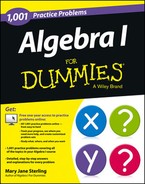Chapter 6
Creating More User-Friendly Algebraic Expressions
Algebraic expressions involve terms (separated by addition and subtraction) and factors (connected by multiplication and division). Part of the challenge of working with algebraic expressions is in using the correct rules: the order of operations, rules of exponents, distributing, and so on. Function notation helps simplify some expressions by providing a rule and inviting evaluation.
The Problems You'll Work On
In this chapter, you get to put some of those algebraic rules to practice with the following types of problems:
What to Watch Out For
Here are a few more things to keep in mind:
Adding and Subtracting Like Terms
251–258 Simplify by combining like terms.
251. 4a + 6a
252. 9xy + 4xy − 5xy
253. 5z − 3 − 2z + 7
254. 6y + 4 − 3 − 8y
255. 7a + 2b + ab − 3 + 4a − 2b − 5ab
256. 3x2 + 2x − 1 + 4x2 − 5x + 3
257. 9 − 3z + 4 − 7ab + 6b − ab − 4
258. x + 3 − y + 4 − z2 + 5 − 2
Multiplying and Dividing Factors
259–266 Multiply or divide, as indicated.
259. 4(3x)
260. −9(5y)
261. ![]()
262. ![]()
263. 3xy(4xy2)
264. −5yz2(3y2z)
265. ![]()
266. ![]()
Simplifying Expressions Using the Order of Operations
267–286 Simplify, applying the order of operations.
267. 2 + 6 · 3
268. 9 − 8 ÷ 4
269. 3 · 2 + 4(−3)
270. −6 ÷ 3 − 4 ÷ 2
271. ![]()
272. ![]()
273. 6 − 4 · 2 + 8 ÷ 4 − 1
274. 20 ÷ 5 + 4 · 3 − 1
275. 10 − 4 − 8 + 6 · 2
276. 36 ÷ 6 ÷ 3 + 3 · 2 · 5
277. 4(6 − 3)
278. 5(−3 + 2)
279. ![]()
280. ![]()
281. ![]()
282. ![]()
283. 3 + 2(6−4)
285. 4(6 + 1)−8(3 + 2)
286. ![]()
Evaluating Expressions Using the Order of Operations
287–296 Evaluate the expressions.
287. What is 3x2 if x = −2?
288. What is −5x − 1 if x = −3?
289. What is x(2 - x) if x = 4?
290. What is ![]() if x = −2?
if x = −2?
291. What is 2(l + w) if l = 4 and w = 3?
292. What is ![]() bh if b = 9 and h = 4?
bh if b = 9 and h = 4?
293. What is a0+(n−1)d if a0 = 4, n = 11, and d = 3?
294. What is ![]() C + 32 if C = 40?
C + 32 if C = 40?
295. What is A![]() if A = 100, r = 2, n = 1, and t = 3?
if A = 100, r = 2, n = 1, and t = 3?
296. What is ![]() if x = 6, a = 4, b = 3, and c = 5?
if x = 6, a = 4, b = 3, and c = 5?
Operating with Factorials
297–300 Evaluate the factorial expressions.
297. 3!
298. 6! − 3!
299. ![]()
300. ![]()
Focusing on Function Notation
301–310 Evaluate the functions for the input value given.
301. If f(x) = x2 + 3x + 1, then f(2) =
302. If g(x) = 9 − 3x2, then g(−1) =
303. If h(x) = ![]() , then h(−4) =
, then h(−4) =
304. If k(x) = ![]() , then k(10) =
, then k(10) =
305. If n(x) = x3 + 2x2, then n(2) =
306. If p(x) = ![]() , then p(3) =
, then p(3) =
307. If q(x) = x! + (x−1)!, then q(4) =
308. If r(x) = ![]() , then r(8) =
, then r(8) =
309. If t(x) = ![]() , then t(−3) =
, then t(−3) =
310. If w(x) = ![]() , then w(4) =
, then w(4) =
